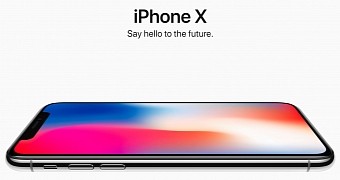The iPhone X is finally a real thing, and after so many months of leaks, contradictory rumors, and speculation on the features the device might or might not have, here we are with an anniversary model that embraces an edge-to-edge display with facial recognition and lots of bells and whistles.
Apple says the iPhone X (which by the way is pronounced iPhone “ten,” so it’ll be interesting to see how Cupertino deals with this when the iPhone reaches its 10th generation) is the smartphone of future, pointing to its feature lineup as living proof.
In the beginning of today’s keynote, CEO Tim Cook said something that made many Android fanboys burst into laughter: the iPhone introduced “innovation after innovation after innovation,” helping change the world and empower people to do more.
And while we’re not going to discuss the way the level of innovation generated by the iPhone since its debut a decade ago, there is something that deserves a little bit more attention. And which, in the end, makes me kind of unimpressed with the iPhone X, and if there are more people like me – and I’m sure there are, Apple has a huge problem.
Innovation? Not really
First and foremost, that innovative approach that Tim Cook has been talking about is almost nowhere to be seen on the iPhone X. Okay, maybe with a few little exceptions, but otherwise what the iPhone X brings is a pack of features that have already been around for many years on rival devices.
Let’s take Face ID, for example. Launched by Apple with much fanfare at today’s event, Face ID is pretty much Windows Hello for iOS. Microsoft introduced Windows Hello on its own Windows phones in October 2015 with the Lumia 950 XL and here comes Apple nearly two years later bringing facial recognition to the iPhone X and marketing it as some kind of groundbreaking innovation.
Nevertheless, it’s not hard to look beyond the fancy words that Apple’s marketing department has prepared for the iPhone X. Face ID is a facial recognition system that’s very similar to the others that are being used in the Android ecosystem, and it works pretty much in the same way.
The funny thing is that Apple’s Face ID comes with the same bugs we’ve seen two years ago on Windows Hello. When I tested the Lumia 950 XL, one of my biggest complaints was that Windows Hello was rather slow and sometimes failed to detect my face, in the end requiring me to turn to other unlocking options.
During today’s event, Face ID failed for the very first time as part of the very first public demo, showing that despite launching 2 years after the first non-Apple iteration, it’s still suffering from the same issues.
Next thing, the wireless charging. Apple describes wireless charging as a feature that’s going to change the world completely, but people have been charging their phones wirelessly for many years already. Android devices have had this for a long time, so again, don’t be fooled by Apple’s fancy marketing words.
Fast charging? Not even mentioned
Cupertino itself appears to be more or less aware of the fact that the iPhone X isn’t such a big revolutionary product as it claims it to be, and for example, while the device will indeed support fast charging, the company hasn’t said a single thing about it. Fast charging will be coming to the iPhone, but only a few years after Android phones started offering it to their customers.
So while Apple says the iPhone X is by all means the living proof of its hunger for innovation, it’s not. And the worst thing is that it could have been, only that the company failed in a very disappointing way.
Let’s get back to the two features mentioned above. The removal of the home button is a bigger deal than Apple says, and Face ID is actually a backup plan that the company turned to after failing to embed the fingerprint sensor into the display. This was something truly innovative, but Apple’s project failed despite several prototypes, so the firm eventually decided to embrace plan B and go only with facial recognition.
Then, it’s the wireless charging again. This feature works with a charging plate, just like on Android devices, but Apple could have made it work in a way that would have completely changed your life.
Patents have shown that Apple has at least considered developing a wireless charging system that would work across the room, and the technology was first spotted in 2015. This means the company had approximately 2 years to finalize the feature, and if the 10th anniversary iPhone doesn’t deserve such a feature, I’m not sure any other model does.
A rushed product
Apple has tried to keep all the bad things about the iPhone X away from our eyes, but there are the little details that do reveal the truth. The October 27 release date shows that the iPhone X is indeed suffering from supply issues, and these were caused by Apple waiting until the very last minute to finalize development of a fingerprint sensor embedded into the screen.
Because this plan eventually failed, Apple started production of the iPhone X later than usual, and this leads to major delays for the device.
So in the end, the iPhone X appears to be more of a rushed product whose level of innovation isn’t the one that Apple is talking so proud of. Will the iPhone X sell well? Probably yes, but on the long term, the company won’t afford to lie people to their faces over and over again.

 14 DAY TRIAL //
14 DAY TRIAL //